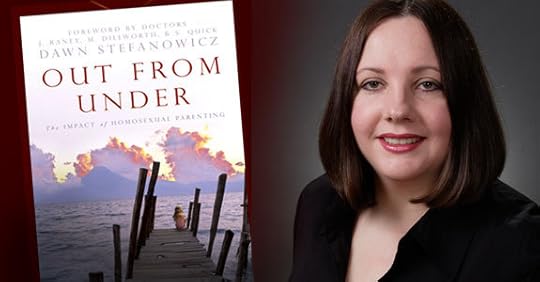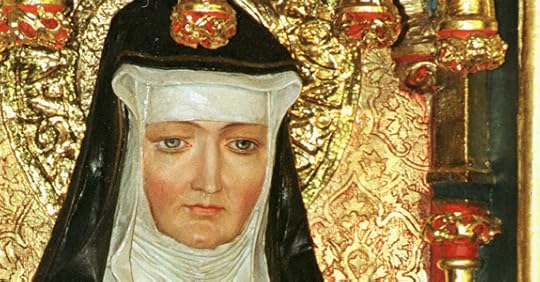Carl E. Olson's Blog, page 211
June 29, 2012
Two about St. Peter; likewise for St. Paul
June 28, 2012
The Voices of 20th-Century Chinese Martyrs
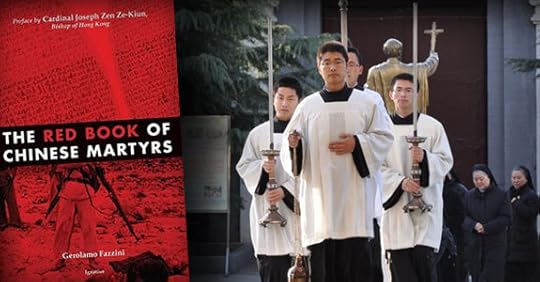
The Voices of 20th-Century Chinese Martyrs | Anthony E. Clark, Ph.D. | Catholic World Report
The stories of those Catholics persecuted under Mao are powerful, if often suppressed, evidence of the faith of the Chinese people.
The truth is always more complicated than fiction. While it is tempting to portray the Church in China in monochrome, a more accurate depiction provides us with a polychromatic canvas, and this more truthful painting casts more honest lights on both China and the Church. Let me give you an example.
When the founder of the Society of the Divine Word, Johann Baptist von Anzer, established his mission in China during the late 19th century, he brought with him an intense German nationalism, just as the French Jesuits had carried French nationalism with them when they built churches, schools, and French market areas in Shanghai. When Anzer arrived at his mission he 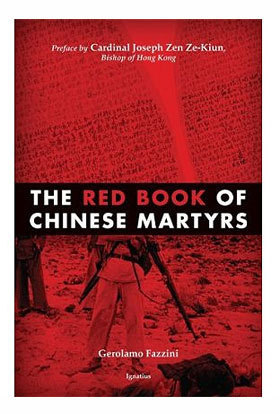 draped a massive German flag from his church steeple and above the veranda of his rectory he installed a sign that read, “Vivat, crescat, floreat Germania,” or “May Germany live, flourish, and grow.” German nationalist songs were often intoned from his chapel with brio, and the native Chinese wondered if missionaries like him came to convert China or colonize it. Only a short decade previously, Britain had bombed China’s shores and bullied its court into legalizing the sale of Western opium, as well as to open all China to foreign missionaries. It did not help matters that Christian missionaries were thereafter connected to guns and opium in the eyes of most Chinese. There is little mystery, then, why common Chinese had become suspicious of Westerners and their religion. But despite appearances, most missionaries were not in favor of guns and opium, nor were most missionaries in favor of open displays of European nationalism.
draped a massive German flag from his church steeple and above the veranda of his rectory he installed a sign that read, “Vivat, crescat, floreat Germania,” or “May Germany live, flourish, and grow.” German nationalist songs were often intoned from his chapel with brio, and the native Chinese wondered if missionaries like him came to convert China or colonize it. Only a short decade previously, Britain had bombed China’s shores and bullied its court into legalizing the sale of Western opium, as well as to open all China to foreign missionaries. It did not help matters that Christian missionaries were thereafter connected to guns and opium in the eyes of most Chinese. There is little mystery, then, why common Chinese had become suspicious of Westerners and their religion. But despite appearances, most missionaries were not in favor of guns and opium, nor were most missionaries in favor of open displays of European nationalism.
I often tell my students that propaganda involves telling only one side of a story. And the more they read about history based on primary sources the more they agree with this assertion. Too often, historical monographs provide biased and un-nuanced depictions of the past, recounting a history that validates one’s preconceptions rather than explain what really happened.
Gerolamo Fazzini’s The Red Book of Chinese Martyrs, a collection of primary biographies, autobiographies, and documentation of Catholic martyrdom in modern China, provides readers with first-hand testimonies of the turbulent Maoist era; readers can decide for themselves how to interpret China’s policies regarding the Catholic Church from 1949 until Mao’s death in 1976. And by presenting these sources unedited, Fazzini avoids propaganda, allowing those witnesses to present both the brutal years of suppression and the more lenient years that followed Mao.
The Maoist interpretation of Christianity in China was formed both by Mao’s knowledge of Western imperialism (mixed as it was with mission churches marked by foreign flags) and Marxist materialism, which views religion as a form of self-comfort under the yoke of class exploitation. There is almost no evidence that Mao, or his comrades, truly understood the history, belief, and goals of Christianity apart from its nationalist underpinnings. While there were a few Christian missionaries, both Catholic and Protestant, who indeed embraced the imperialist enterprise in China, it is incontestable that the greater majority of these foreigners loved China and expressed that love through unselfish acts of charity. The manifest value of Fazzini’s book is that it consists of a collection of original testimonies by Chinese Catholics who demonstrate a profound love of their own culture, while also expressing an abiding belief in God in an era of forceful transition. We do well to recall as we read these testimonies that it was not Chinese culture that most harshly persecuted Christianity, but rather Western Marxist materialism that inspired the suppression of all religious commitment.
Read the entire article at www.CatholicWorldReport.com.
The Introduction to The Red Book of Chinese Martyrs, by Gerolamo Fazzini, can be read on Ignatius Insight.
June 27, 2012
Why is Jerry Sandusky Guilty?
By Benjamin Wiker for Catholic World Report:
There is no doubt that Jerry Sandusky is guilty, the real question is why? Why is it that we, here and now, would send a man to prison for molesting boys? Why is the public reaction one of both deep disgust and quite visceral anger? Just canvass a few opinions about what people would like to be done to punish Sandusky if they were the judge.
But why? What is the cause of this deep disgust? This seething anger?
There is only one cause: Christianity. We still have minds, consciences, and hearts, and hence a legal system, historically formed by Christian moral principles. There is no other reason. Allow me to explain, beginning first with the “that” of his guilt.
Jerry Sandusky has been declared guilty of 45 of 48 counts of child sexual molestation. The coaching hero of Penn State used his status to draw in young boys through his Second Mile charity, “a statewide, nonprofit organization for children who need additional support and who would benefit from positive human contact” (so the website maintains). The “positive human contact” Sandusky had in mind occurred in locker rooms, motel rooms, his basement, and who knows where else. He molested (at least) one of his adopted sons.
This is 2012. Turn the historical clock back 2000 years, and find yourself in the pagan Roman Empire before Christianity arose, i.e., before the Christianization of the West. In Rome, as in ancient Greece, homosexuality was completely acceptable. To be more exact, homosexual activity was frowned on (but not very diligently) when it occurred between two free-born men, but it was cheerfully affirmed between a master and his slave, and even more, a man and a boy between the ripe ages of about 12 to 17—just the target age of Sandusky. The man generally presented himself as a kindly benefactor to the boy, taking him under his wing, so to speak, and (in return for sexual favors) helping him up the social ladder. Just like Sandusky.
If Sandusky would have lived 2000 years ago, he would not have been found guilty of anything. He would not even have been noticed. His actions would have been entirely unremarkable. There would have been no disgust, no anger. The verdict would have been innocent, and in fact, the notion that he was guilty of anything would have been unintelligible.
New: "Divine Love Made Flesh" by Raymond Cardinal Burke
Now available through Ignatius Press:
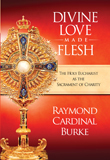 Divine Love Made Flesh:The Holy Eucharist as the Sacrament of Charity
Divine Love Made Flesh:The Holy Eucharist as the Sacrament of Charity
by Raymond Cardinal Burke
Cardinal Burke examines the beauty and power of the Most Holy Sacrament of the Eucharist in light of the profound and elucidating teachings of Blessed Pope John Paul II and Pope Benedict XVI.
Using clear and illuminating language, Cardinal Burke guides one through the beautiful teaching of the Church on this Most Holy Sacrament and its central place in the life of every disciple of Jesus Christ.
Truly inspiring, this spiritual treatise on the central Mystery of our Faith links the rich theology of the Church with pastoral practice and the spiritual life. To this end, Cardinal Burke's marvelous ability to speak to the layman in simple yet profound language is sure to engender or deepen the love of the Eucharist in the hearts of all who read it.
Raised Under the GLBT Umbrella: An Interview with Dawn Stefanowicz
Raised Under the GLBT Umbrella | Jim Graves | Catholic World Report
Dawn Stefanowicz grew up in a home where the sexual desires of adults were put ahead of her needs and well-being. Today she fights for traditional marriage and a child’s right to a mother and father.
Same-sex marriage is the cause célèbre of many politicians and celebrities, and is extensively covered in the news. As debates rage, one central issue is often overlooked, believes Canadian author and speaker Dawn Stefanowicz: how does being reared in a same-sex household effect children?
Many states already allow same-sex couples to adopt children, a practice that will be further cemented in law as more states issue marriage licenses to homosexual couples. Additionally, some homosexuals have children of their own from previous opposite-sex relationships. Dawn brings a rare voice to the public discussion; her father was actively involved in the gay lifestyle, and she describes herself as “raised under the GLBT [gay, lesbian, bisexual and transgender] umbrella.”
Dawn was born in Toronto. Her father became an active homosexual at an early age. He was a successful businessman. Desiring children, he married, and the relationship produced Dawn and two brothers, one her twin. After Dawn and her brother were conceived, their father ended sexual relations with his wife, and pursued homosexual relationships at well-known gay meeting places in Canada and the United States. Dawn was often brought along to many of these locations, even as a child. Her father had numerous gay lovers, and brought them into the home. At age 51, in 1991, he died of AIDS.
Today, Dawn lives in Ontario, Canada. She is a licensed accountant, a Christian, a public advocate of children being reared in homes with opposite-sex, married couples, and a vocal defender of traditional marriage. She has been married to a man for 28 years, and has two teenaged children. In 2007, she published Out From Under: The Impact of Homosexual Parenting, a book about her experiences growing up in the GLBT world. On the occasion of the fifth anniversary of the release of her book, she spoke with Catholic World Report.
Why did you decide to share your story of being “raised under the GLBT umbrella” in your book and your speaking engagements?
Dawn Stefanowicz: I felt compelled. I made a public appearance before Canada's Senate of Legal and Constitutional Affairs committee in Ottawa in 2004, asking that they not add “sexual orientation” to the existing hate-crime legislation due to restrictions on freedom of speech and religion. Later that month, I shared my testimony before a school board. Almost immediately, gay activists who had been bussed in—and I should say I dislike using the term “gay,” but it’s commonly used today, so I will—began shouting at me as I testified so that you couldn’t even hear what I was saying. A half dozen times I was interrupted. I was concerned for my safety, so I asked a security guard for an escort to my car. I went home and began writing my book. I wanted to share my experiences growing up in a same-sex household.
Continue reading this interview at www.CatholicWorldReport.com.
June 26, 2012
Benedict XVI on the “What” and “Why” of Baptism
by Fr. James V. Schall, S.J.
“Why isn’t it sufficient for discipleship to know the teachings of Jesus, to know the Christian values? Why is it necessary to be baptized?”
— Pope Benedict XVI, “Lectio Divina,” St. John Lateran, June 11, 2012.
“I was born not because I made myself man, but I was born because being human was given to me.”
— Pope Benedict XVI, June 11, 2012.
I.
Benedict XVI speaks often and at length on baptism. At first sight, it seems a rather messy and inconvenient ceremony, all that water, candles, oil, and—not infrequently—crying babies. The first thing we must know about baptism is that it is not a human invention, though it is a human thing. It is unlikely anyone would sit down and figure out that pouring water over the head of someone would mean anything but normal cleansing. John the Baptist, however, was said to baptize with water, but Christ, to whom he witnessed, baptized with water and the Holy Spirit.
In a reflective “reading” at the Basilica of St. John Lateran, Benedict again took up the importance of baptism. Over the course of his Pontificate, the Holy Father has given fourteen other homilies on baptism when he himself has administered the sacrament—seven on the Sunday after the Epiphany and seven at the Easter Vigil. In Spe Salvi, he also recalled the rite of Baptism, the part where the priest asks the parents or the one to be baptized what he wants from the sacrament. The answer is: “Eternal life.”
Ultimately, this eternal life is why we exist, that we may obtain it. It is a gift to us. It is not the result of our own enterprise or of our own nature.
Benedict begins by pointing out that baptism repeats the last recorded words of Christ in the Gospels. The Apostles were charged with going forth to make all nations His disciples and to baptize each one in the name of the Father, the Son, and the Holy Spirit. We are baptized in the name of the Trinity; we mention each Person. We are to be “immersed” in God—we, who are human beings.
The Pope recalls a conversation Christ had with the Sadducees. These latter only admitted as legitimate scripture the first five books of Moses. In them, resurrection is not mentioned, which was the Sadducees’ reason for not believing in this teaching. But Jesus responded to them in words that reflected the books they did accept. “Did you not know that God calls himself the God of Abraham, Isaac, and Jacob?” (Matt 22:31). That is, He is the God of the living, which includes the three figures found in these early books. In other words, Christ gave the Sadducees enough challenge to see their own contradictions.
Save 20% off new and newly released Ignatius Critical Edition titles

20% off new and newly released Ignatius Critical Edition titles!
Summer is officially upon us. What better way to enjoy the longer, warmer days than with some great, classic reading material. New titles in the Ignatius Critical Edition series are now available. These new titles, along with some of the other recently released titles, are being offered at 20% off for one week. With new lower prices on all the ICE titles this offer is a great deal to take advantage of! These Great Books, which include outstanding critical essays, help readers go deeper in understanding these outstanding works of literature--from a tradition-oriented perspective.
Books
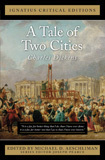 A Tale of Two Cities
A Tale of Two Cities
Charles Dickens
In A Tale of Two Cities, Charles Dickens expresses sympathy for the downtrodden poor and their outrage at the self-indulgent aristocracy. Humanity does not show its best side in the mean streets of Paris or even London, but in the intimate circle of loyal friends that gathers around the honorable Doctor Manette and his lovely daughter, Lucie.
Regular price: $11.95, sale price: $9.56
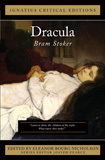 Dracula
Dracula
Bram Stoker
When solicitor's clerk Jonathan Harker travels to Transylvania on business to meet a mysterious Romanian count named Dracula, he little expects the horrors this strange meeting will unleash. Thus Bram Stoker's 1897 novel of blood and passion begins, rapidly accelerating from Harker's nightmarish experiences in Castle Dracula to a full-fledged vampiric assault on late-Victorian London itself.
Regular price: $11.95, sale price: $9.56
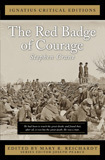 The Red Badge of Courage
The Red Badge of Courage
Stephen Crane
Stephen Crane described his novel of the American Civil War as a "psychological portrait of fear." Although he never experienced the horror of battle himself, Crane based his realistic narrative largely on stories told by Civil War veterans. In a sense, modern American fiction begins with Crane's masterful, impressionistic depiction of Private Henry Fleming under fire.
Regular price: $7.95, sale price: $6.36
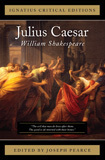 Julius Caesar
Julius Caesar
William Shakespeare
Though a staple in high school English classes, Julius Caesar is not a simple play. Seemingly irreconcilable forces are at work: fate and free will, the changeableness and stubbornness of ambitious men, the demands of public service and the desire for private gain. Drawn from history as recorded by Plutarch, the major characters-Caesar, Brutus, Cassius, and Mark Antony-are complex, as are the twists and turns of their fortunes.
Regular price: $5.95, sale price: $4.76
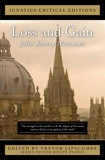 Loss and Gain
Loss and Gain
John Henry Newman
This novel about a young man's intellectual and spiritual development was the first work John Henry Newman wrote after entering the Roman Catholic Church in 1845. A former Anglican clergyman who was later named a Catholic cardinal, Newman wrote this autobiographical novel to illustrate his own reasons for embracing Catholicism.
Regular price: $9.95, sale price: $7.96
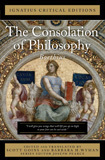 The Consolation of Philosophy
The Consolation of Philosophy
Anicius Boethius
Written in the sixth century, The Consolation of Philosophy was one of the most popular and influential works of the Middle Ages. Boethius composed the masterpiece while imprisoned and awaiting the death sentence for treason. In the Consolation, Boethius explores the true end of life-knowledge of God-through a conversation with Lady Philosophy. Part prose, part poetry, the work combines Greek philosophy and Christian faith to formulate answers to some of life's most difficult and enduring questions.
Regular price: $7.95, sale price: $6.36
Romeo and Juliet
William Shakespeare
"Star-crossed" Romeo and Juliet are Shakespeare's most famous lovers. A staple of high school reading lists, the tragedy especially resonates with young adult readers who, like Romeo and Juliet, have experienced the exhilarating and perilous phenomenon of being "in love".
Regular price: $5.95, sale price: $4.76
Great Expectations
Charles Dickens
In Great Expectations, Pip—symbolic of the pilgrim convert—gains both improved fortunes and a growth in wisdom, but as he acquires the latter, he must relinquish the former—ending with a wealth of profound goodness, not of worldly goods.
Regular price: $11.95, sale price: $9.56
Macbeth
William Shakespeare
This critical edition of Shakespeare's classic psychological drama contains essays by some of today's leading critics, exploring Macbeth as a morality play, as a history play with contemporary relevance, and as a drama that shows a vision of evil and that grapples with the problem of free will.
Regular price: $5.95, sale price: $4.76
Moby Dick
Herman Melville
A sea adventure, a study of evil, and a cast of fascinating characters, including the crazed captain who is obsessed with hunting down the whale that maimed him - Moby Dick is all of this and more.
Regular price: $11.95, sale price: $9.56
Mansfield Park
Jane Austen
In all things, Jane Austen was a woman of faith. Perhaps nowhere is this more apparent than in Mansfield Park, her most neglected, abused, and misunderstood novel. Like Austen's other novels, it can be fully appreciated only when illuminated by the virtuous life and Christian beliefs of the author herself.
Regular price: $11.95, sale price: $9.56
Gulliver's Travels
Jonathan Swift
Swift's satire on the threats posed by the Enlightenment and the embryonic spirit of secular fundamentalism makes Gulliver's Travels priceless reading for today's defenders of tradition. This new critical edition, edited by Dutton Kearney of Aquinas College, contains detailed notes to the text and a selection of tradition-oriented essays by some of the finest contemporary Swift scholars.
Regular price: $9.95, sale price: $7.96
Save 40% off Alison Faulkner's "Employee Pick of the Week"

40% off Alison Faulkner 's Pick of the Week*
 My favorite Ignatius Press book is A Song for Nagasaki (also available as an e-book and audio download) by Paul Glynn. It is a moving story of Takashi Nagai, a survivor of the nuclear destruction of Nagaski in World War II. The story begins with Nagai's childhood and moves through his remarkable spiritual journey from Shintoism to atheism to Catholicism. Not only does the biography deal with his spiritual journey, it is also a story mixed with details about Japanese history and culture as well as Nagai's love of science--especially the field of radiology. He devoted tireless hours to research, and after the A-Bomb destroyed much of Nagasaki, he helped the suffering survivors. All the while dealing with his own suffering.
My favorite Ignatius Press book is A Song for Nagasaki (also available as an e-book and audio download) by Paul Glynn. It is a moving story of Takashi Nagai, a survivor of the nuclear destruction of Nagaski in World War II. The story begins with Nagai's childhood and moves through his remarkable spiritual journey from Shintoism to atheism to Catholicism. Not only does the biography deal with his spiritual journey, it is also a story mixed with details about Japanese history and culture as well as Nagai's love of science--especially the field of radiology. He devoted tireless hours to research, and after the A-Bomb destroyed much of Nagasaki, he helped the suffering survivors. All the while dealing with his own suffering.
Reading about the selflessness of Takashi Nagai in dealing with his own hardships while 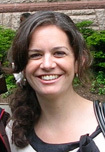 helping others was amazing. I recommend this book to anyone who needs a little spiritual inspiration. Throughout Nagai's journey, he sought answers to every question and doubt he encountered, and it was by the grace of God that he was able to live his life the way he did. This truly is a deeply moving and remarkable story.
helping others was amazing. I recommend this book to anyone who needs a little spiritual inspiration. Throughout Nagai's journey, he sought answers to every question and doubt he encountered, and it was by the grace of God that he was able to live his life the way he did. This truly is a deeply moving and remarkable story.
Six years ago, with a car packed full of her belongings, Alison made the journey (with the wonderful assistance of her Mother) from her hometown in Canada to California. Alison is in charge of keeping the Ignatius website up-to-date, sends the weekly email blasts, and is involved in a variety of other tasks in the marketing department.
*Employee Pick of the Week program features savings of 40% off a book, movie, or compact disc personally chosen and recommended by an Ignatius Press employee. Each week, an Ignatius Press employee will select a favorite book, movie, or other Ignatius Press product and write a few sentences about why he/she thinks customers will enjoy the particular selection. A short bio of the selecting employee will also be included, giving customers a chance to learn a bit more about the people who are Ignatius Press.
June 25, 2012
The Chancellor's son on facing Hitler and fighting for freedom
When Hitler Took Austria: A Memoir of Heroic Faith by the Chancellor's Son (Ignatius Press, 2012; also available in Electronic Book Format), by Kurt and Janet von Schuschnigg, is the incredible story of Austrian Chancellor Kurt von Schuschnigg and his family during and following the invasion and overthrow of Austria by the Nazis. Kurt von Schuschnigg's memoir is a deeply personal account of resistance, escape, and survival; it is also a story of deep faith and hope in the face of tyranny, persecution, and the nearly constant possibility of death.
Catholic World Report recently interviewed Kurt von Schuschnigg about the book, co-authored with his wife, Janet.
CWR: In addition to telling your account of the harrowing decades of the 1930s and beyond, When Hitler Took Austria also seeks to set the record straight on some counts. What are some of the misunderstandings or misrepresentations the book addresses? Do some of them have to do with your father and his time as Chancellor of Austria?
Kurt von Schuschnigg: The first glaring misrepresentation stems from a bill before parliament on March 3, 1933, that the Socialists wanted very much to pass. They were one vote short. There are three presidents in parliament. The first cannot vote; the other two can. The first president was Karl Renner, head of the Socialist Party. On the advice of Otto Bauer – chief spokesman for the Socialist party – Karl Renner resigned, thus allowing Renner to cast a vote. Renner’s office passed to the second president, a Christian Social of the party of Dollfuss and Kurt von Schuschnigg. Rudolf Ramek knew that Renner’s purpose was to deny Ramek his vote, 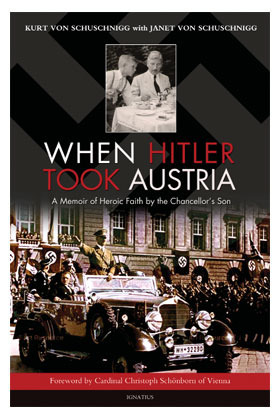 therefore gaining two votes for the Socialists. Ramek resigned. The third president from the small Pan German party wasn’t going to be left holding the ball. He resigned as well. Thus, parliament had dissolved itself. It is Dollfuss who is falsely blamed in many history books for this dissolution.
therefore gaining two votes for the Socialists. Ramek resigned. The third president from the small Pan German party wasn’t going to be left holding the ball. He resigned as well. Thus, parliament had dissolved itself. It is Dollfuss who is falsely blamed in many history books for this dissolution.
Dollfuss could have called for new elections or recalled parliament. Instead, using the Emergency Empowering Law of 1917, he called for a new constitution – namely the corporate state. This was a form of government that Pope Pius XI had endorsed in his encyclical of 1931. It was representation by professions and trade unions instead of political parties. Both Dollfuss and Kurt von Schuschnigg were fully aware of Adolf Hitler, who had been active since the early 1920s. They had also read “Mein Kampf,” which clearly stated Hitler’s intentions towards Austria. Dollfuss could not have expelled the Nazi party alone. That would have been an invitation for Hitler.
Furthermore, for years the intransigence of the Socialist Party – whose credos were ‘the overthrow of the bourgeoisie government by any means’ and ‘the dictatorship of the proletariat’ – had caused a virtual stalemate in parliament. The benefits to Austria without the danger of the Nazis and the obstructions of the Socialists were obvious. One of Otto Bauer’s responses to this was the coinage of the phrase ‘Austro Faschismus,’ a theme to which the Socialists dedicated themselves to perpetuate – along with the equally slanderous description of Engelbert Dollfuss as a ‘dictator.’
CWR: Your book opens with a quote from Mein Kampf, in which Adolf Hitler expressed his "longing" for Austria to "return to the great German mother country.” How did that "return" come about? And how was Hitler and the Nazis perceived and received by the Austrians?
Kurt von Schuschnigg: That ‘return’ was helped by a massive influx of propaganda by Nazi minister Josef Goebbels. By the end of 1934, Germany had spent more than 5 million reichmarks on Austrian propaganda. There were endless streams of radio transmissions; leaflets dropped from airplanes; and unending newspaper articles through which Germany painted Austria as weak and poor, and compared it to the prosperity and power of the Third Reich. Like a drop of water on a piece of marble, eventually it will cause a break in the surface.
The invasion of Germany on March 12, 1938, was an enormous curiosity for many Austrians. The Nazis among them were jubilant. Kurt von Schuschnigg had refused to send Austrian soldiers to certain death. The Austrian Army was massively outnumbered and had only several days worth of ammunition.
CWR: As someone who witnessed firsthand the work and destruction of the Nazis, how would you explain the appeal and hold of Hitler's philosophy and personality?
Kurt von Schuschnigg: The Socialists had already prepared the groundwork by damning the Catholic Church for trying to impose church doctrine, thus restricting their freedom. Hitler wanted to replace religion with German mythology. The aims of the Third Reich were to portray Germany as origin of the Arian race, and the propagation of that master race and of strength through happiness. Hitler’s rhetoric mesmerized his audiences. The unending displays created through pomp, pageantry and theatrics were unfailingly impressive.
CWR: You describe a brief but memorable encounter, as it were, with Hitler, when you were a teenager. How did that take place and what do you recall of the moment?
Kurt von Schuschnigg: I was riding my bicycle to visit my friend, who lived across from Hitler’s Munich residence. Not too many blocks before reaching my destination I became aware of a column of vehicles. It began passing me. I looked over at the exact moment Hitler’s open landau was next to me. I suppose my jaw dropped for I was certainly amazed. He stared straight at me and taking my astonishment for admiration he gave me the Nazi salute. A dozen thoughts raced through my mind. But most prevalent were that his freckled neck squished over his collar, and his moustache looked absolutely ridiculous.
CWR: The importance of your faith as a Catholic is evident throughout the book. How did faith sustain you and your family during the war? And who were some Catholics from your youth who helped you along the way?
Kurt von Schuschnigg: I grew up with a family who believed in the power of prayer. My father was an exceptionally strong Catholic. Without his faith to sustain him, he would have never survived after 1938. After father’s arrest, Pope Pius XI sent him a papal autograph in which he named Father, my step-mother and me. The pope wrote at the bottom of the document that, “If at the hour of your death you are unable to pronounce the name of Jesus your sins are forgiven.” I held that thought tightly throughout those war years. I will always remember one of the acts of valor by Bishop (later Cardinal) Preysing. He sent word that I should visit him in Berlin, which was not a great distance from the Sachsenhausen concentration camp. When I did so, he entrusted me with delivering Holy Communion to Father. Bishop Preysing was a fearless leader of the church. But such things were not to be tolerated by the Third Reich. I still thank God that we were not caught.
CWR: What are some lessons, or observations, about freedom and faith that can be drawn from your experiences as a young man?
Kurt von Schuschnigg: My father always said there was freedom, and there was the freedom of fools. The former is precious, something to be guarded. The latter is what can happen with the misuse of freedom. I do not believe that today’s use of the First Amendment was ever envisioned by our forefathers – nor was the expulsion of God from classrooms, courthouses and endless other locations in our lives. And I am concerned for the children of today. If a child does not grow up in a family who worships God how is he or she ever to acquire faith? Today’s media – TV, movies and print – expose every aspect of human nature. The boundaries of decency have disappeared. How can we preserve our children’s childhoods?
(For more about the book, including a video trailer and ordering information, visit the book's page.)
A Beginner’s Guide to the Music of St. Hildegard of Bingen
A Beginner’s Guide to the Music of St. Hildegard of Bingen | Christopher S. Morrissey | Catholic World Report
A playlist of beautiful compositions by the soon-to-be Doctor of the Church.
St. Hildegard of Bingen (1089–1179) will soon be the Catholic Church’s 35th Doctor. The formal proclamation will make her the fourth woman to be declared a Doctor of the Church, joining the ranks of Saints Teresa of Avila, Catherine of Siena, and Therese of Lisieux.
Pope Benedict announced on Pentecost Sunday during his Regina Coeli address that now, after having formally declared (on May 10, 2012) Hildegard’s sainthood by way of “equivalent canonization,” he will proclaim (on October 7, 2012) that Hildegard is an official Doctor of the Church.
Benedict seems to have a soft spot for Hildegard. Back in 2010, he devoted not one but two of his Wednesday general audience talks to her. Perhaps this is related to his well-known love for all the best music.
Consider this: For how many saints can you say that you have a playlist of audio files? But with St. Hildegard, Benedict has amped up the ranks of Church Doctors who can teach us about what sacred music at its best sounds like.
Hildegard’s music had something of a “pop culture” moment back in 1994, when Richard Souther’s album Vision: The Music Of Hildegard von Bingen became a hit. It ended up winning the Billboard Classical/Crossover album of the year award.
Purists recoiled at Souther’s blending of Hildegard’s Gregorian chants with electronic effects and additional modern instrumentation. But who is to say that future artists should rule out any similar innovations as they rediscover Hildegard’s music for the 21st century?
Carl E. Olson's Blog
- Carl E. Olson's profile
- 20 followers






